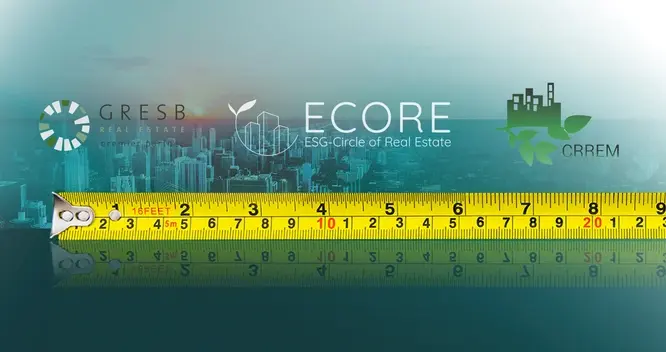CRREM, ECORE or GRESB? Just make sure it’s at the touch of a button.

Reading time 5 minutes - enjoy the read!
How sustainable is a specific real estate portfolio and how does it compare? Real estate is highly individual – whether in terms of structure, fit-out or location – and is used in very different ways, from warehouses and data centers, to hotels and offices. Does that even matter? Why is energy consumption in one building so much higher than in the rest of the portfolio? Where do we need to focus our efforts to achieve the greatest positive impact? To answer all these and many other essential questions, we need objective, easily comparable data. Almost everyone has heard of the “Body Mass Index,” or “BMI” for short. This relatively simple formula takes two variables, height and weight, and tells us whether we are in, above or below the normal weight range. Apart from providing a simple personal point of orientation, there is another great advantage of the BMI: It takes individual parameters and makes them objectively comparable and assessable. What does that have to do with real estate? It is exactly what CRREM, ECORE and GRESB provide. BuildingMinds is an ECORE (ESG Circle of Real Estate) ESG Solution Partner, as well as being a GRESB (Global Real Estate Sustainability Benchmark) Premier and Data Partner. In addition, we dovetailed our ESG platform with CRREM (Carbon Risk Real Estate Monitor) from day one.
The reporting dilemma
Problem solved, you might think? Well, unfortunately, the sustainability of real estate cannot be measured using a simple formula with only two variables. On the contrary, the measurement of sustainability in general and, in particular, in compliance with reporting according to CRREM, scoring according to ECORE, or benchmarking according to GRESB, is based on a huge number of variables, many of which are dynamic. Water consumption plays an equally important role as energy consumption, including electricity, heating and hot water, or the volume and type of waste produced. And these are only the most important, and at the same time most tangible, factors. We have not even touched on gray emissions, i.e. emissions released during construction. Collecting and evaluating these data manually leads us straight into a reporting dilemma and quickly becomes a Sisyphean task: By the time you have finished, the results are already obsolete.
"In order to dynamically depict sustainability in actionable figures, we need untold data - and at the push of a button."
Dr. Jens Hirsch
Head of Sustainability and Scientific Research at BuildingMinds
The good news is that there is a significant overlap between the sustainability data you need for each solution. So, once you have established ECORE scoring, you already have a good basis for implementing GRESB, for example. An automated data collection and analysis not only allows for defined reporting date statements, whether according to ECORE or GRESB, it also provides daily insights, in near-real time. Incidentally, this allows to improve with a highly structured approach and opens up many other areas of application beyond sustainability. Digitalization offers a viable route out of the dilemma described above. Digital technologies, such as the BuildingMinds ESG platform, immensely simplify data collection, maintenance and evaluation. Once you have set up a database, our platform operates automatically, whatever the application. Dynamic data, such as consumption data, flows directly into the platform via interfaces and is constantly added to the database. Such complex analyses with countless variables and constraints can only be managed by digital technology. The end result is not just reporting at the push of a button, but a starting point for far, far more.
Lean back and relax?
There are only a good seven years until 2030 and that’s the EU’s deadline for reducing carbon emissions by 55 percent compared to 1990. And the targets don’t stop there. By 2050, the aim is to be completely carbon neutral. If you only want to achieve the absolute minimum, this is the point at which you can perhaps (briefly) lean back and relax. If, however, you really are focused on the matter at hand, this is merely where the process begins.Using an integrated data platform, one can dynamically adapt their sustainability strategies, initiate immediate responses to anomalies, and thus generally align their day-to-day business operations with their sustainability targets. The BuildingMinds data platform seamlessly integrates with CRREM, which specifies scientifically substantiated reduction pathways for each property derived from the Paris climate targets. These are, after all, the ultimate benchmarks for anyone who wants to avoid being saddled with stranded real estate assets. This iterative process – i.e., dynamically reacting to change – is probably the greatest lever for greater sustainability in the real estate industry. If you want to lose weight or build muscle, do you step on the scales once a year, adjust your behavior accordingly, and that’s it? Our industry all too often thinks in terms of decades-long product life and reporting cycles based on key reporting dates. The time for truly effective change is now: CREEM, ECORE, and GRESB provide the route, digital technology gives us the tools we need.
"Whether a real estate company’s primary concern is regulatory compliance or contributing to the greater good: We need to take action – and better yesterday than today."
Jens Mueller
CEO BuildingMinds



